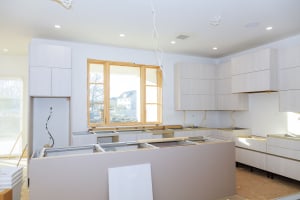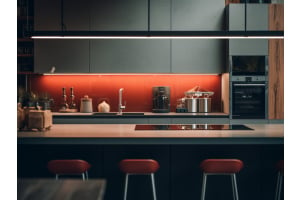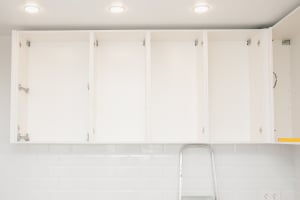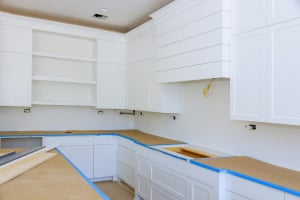Wall panels can make your space feel homey and warm, but if your wood veneer wall paneling is looking dated, cracked, or damaged, it can take away from the outlook of your room. You can install new paneling, but this can be costly.
If you’re working on a tight budget, worry not–a fresh coat of paint is a great way of covering up old wall paneling without breaking the bank! Here is a simple guide on how to paint your wall panels to bring new life to your home interior.
What You’ll Need
Here is what you’ll need to paint your wall panels like a pro:
- Trisodium phosphate (TSP)
- Paint primer
- Paint
- Sandpaper
- Rubber gloves
- Protective goggles
- Respiratory mask
- Bucket
- Sponge
- Tack cloth
- Drop cloths
- Vacuum
- Painter's tape
- Paint roller
- Foam sponge
How to Paint Wall Panels
Step 1: Cleaning and Preparing
Any dust, debris, or fingerprints on your panels can prevent the paint from sticking properly, resulting in an uneven finish. To prevent this, cleaning and prepping your panels are very important.
Start by thoroughly washing the panels with a highly diluted solution of trisodium phosphate.
Make sure to take all safety precautions before handling this toxic cleaner–open all windows in the room to allow for proper ventilation, and wear protective gear, including rubber gloves, a respiratory mask, protective eye glasses, and full-sleeved clothing.
The safest way to clean is to use a soft sponge dampened in a dilute TSP solution to gently wipe the panels down.
Step 2: Sanding and Scuffing
The next step is to lightly sand the panels using a technique known as ‘scuffing.’ We recommend using 220-grit sandpaper to gently sand the panels using circular motions.
The sanding aims to roughen up the surface enough to create a good mechanical bond between the wall and the primer and paint you apply. Make sure to wear a dust mask, keep your vacuum handy, and wipe away any dust with a damp rag or a sponge as you go along.
You can skip this step if you use a very high-quality paint primer, but we recommend doing it, anyway. This only takes a few minutes and gives you good protection against chipping paint in the future.
Step 3: Priming
After you’re done scuffing the entire surface of the panel you want to paint, carefully apply a thin coat of primer using a wide brush. Priming helps give a smoother finish by preventing any imperfections, cracks, or wood grain from showing through the final coat of paint.
Make sure to select the right kind of primer. We recommend using a shellac-based primer for veneer, whereas a water-based one will work better if your panels are solid wood.
Also, try getting your hands on ‘stain-blocking’ primer–this will help hide any knots that show up throughout the wood paneling, preventing them from bleeding through your paint job at the end. You can also use a tinted primer to match the color you plan on painting, though this isn’t necessary.
We recommend using a two-inch, high-quality angle brush to start at corners and slowly switch to a roller as you work on a larger surface area. Generally, two thin coats of primer are enough for standard wood panels.
Make sure not to go overboard, as this can leave your paint looking lumpy and uneven at the end. Also ensure that the first coat of primer is completely dry before you apply the next; use the instructions on the label if you aren’t sure how long to wait between the coats.
Step 4: Final Prep
Once the cleaning, sanding, and priming are complete, your panels are now ready for a lick of paint. But before that, make sure to lay down a bunch of newspapers or a drop cloth on the floor where you’ll be painting. This can catch any stray paint splatters while you work, saving you the trouble of scraping them off your floor later.
Step 5: Get Painting
This is the final and most exciting part of the whole process. Once the primer has dried, apply a thin coat of paint over the surface, starting with an angled brush for the corners and moving to a paint roller as you go along.
Make sure you roll the paint on in thin layers and let it dry completely. Pay close attention to any grooves in the panel, ensuring no excess paint is collected, as this can become tacky, clumpy, and thick when dried.
Lightly sand the surface of the wall panel in between coats to remove any thick or uneven clumps of paint. We recommend applying at least two thin layers of paint for complete coverage, but you can adjust this as you see fit. Once the paint dries, fix your panels without adhesive to ensure they last a long time!













